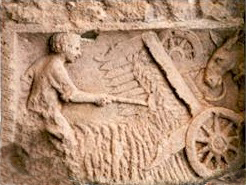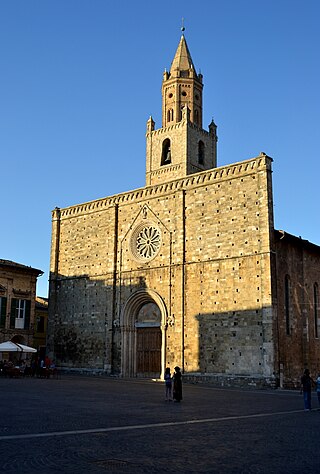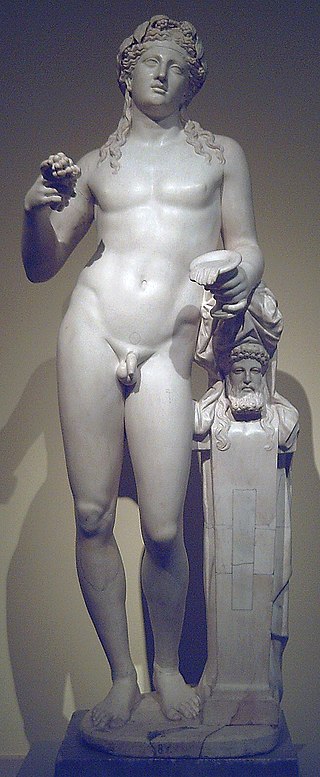Related Research Articles

An amphora is a type of container with a pointed bottom and characteristic shape and size which fit tightly against each other in storage rooms and packages, tied together with rope and delivered by land or sea. The size and shape have been determined from at least as early as the Neolithic Period. Amphorae were used in vast numbers for the transport and storage of various products, both liquid and dry, but mostly for wine. They are most often ceramic, but examples in metals and other materials have been found. Versions of the amphorae were one of many shapes used in Ancient Greek vase painting.

The cuisine of ancient Rome changed greatly over the duration of the civilization's existence. Dietary habits were affected by the political changes from kingdom to republic to empire, and Roman trading with foreigners along with the empire's enormous expansion exposed Romans to many new foods, provincial culinary habits and cooking methods.

Retsina is a Greek white resinated wine, which has been made for at least 2,000 years. Its unique flavor is said to have originated from the practice of sealing wine vessels, particularly amphorae, with Aleppo pine resin in ancient times. Before the invention of impermeable glass bottles, oxygen caused many wines to spoil within the year. Pine resin helped keep air out, while infusing the wine with resin aroma. The Romans began to use barrels in the 3rd century AD, removing any oenological necessity for resin, but the flavor itself was so popular that the style is still widespread today.

The Edict on Maximum Prices was issued in 301 AD by Diocletian. The document denounces monopolists and sets maximum prices and wages for all important articles and services.

Roman commerce was a major sector of the Roman economy during the later generations of the Republic and throughout most of the imperial period. Fashions and trends in historiography and in popular culture have tended to neglect the economic basis of the empire in favor of the lingua franca of Latin and the exploits of the Roman legions. The language and the legions were supported by trade and were part of its backbone. The Romans were businessmen, and the longevity of their empire was caused by their commercial trade.

Roman agriculture describes the farming practices of ancient Rome, during a period of over 1000 years. From humble beginnings, the Roman Republic and the Roman Empire expanded to rule much of Europe, northern Africa, and the Middle East and thus comprised many agricultural environments of which the Mediterranean climate of dry, hot summers and cool, rainy winter was the most common. Within the Mediterranean area, a triad of crops were most important: grains, olives, and grapes.

Monte Testaccio or Monte Testaceo, also known as Monte dei Cocci, is an artificial mound in Rome composed almost entirely of testae, fragments of broken ancient Roman pottery, nearly all discarded amphorae dating from the time of the Roman Empire, some of which were labelled with tituli picti. It is one of the largest spoil heaps found anywhere in the ancient world, covering an area of 2 hectares at its base and with a volume of approximately 580,000 cubic metres (760,000 cu yd), containing the remains of an estimated 53 million amphorae. It has a circumference of nearly a kilometre (0.6 mi) and stands 35 metres (115 ft) high, though it was probably considerably higher in ancient times. It stands a short distance away from the east bank of the River Tiber, near the Horrea Galbae where the state-controlled reserve of olive oil was stored in the late 2nd century AD. The mound later had both religious and military significance.

The study of the Roman economy, which is, the economies of the ancient city-state of Rome and its empire during the Republican and Imperial periods remains highly speculative. There are no surviving records of business and government accounts, such as detailed reports of tax revenues, and few literary sources regarding economic activity. Instead, the study of this ancient economy is today mainly based on the surviving archeological and literary evidence that allow researchers to form conjectures based on comparisons with other more recent pre-industrial economies.

Picenum was a region of ancient Italy. The name was assigned by the Romans, who conquered and incorporated it into the Roman Republic. Picenum became Regio V in the Augustan territorial organisation of Roman Italy. It is now in Marche and the northern part of Abruzzo.
Falernian was a strong white wine popular in the classical Roman period, produced from Aglianico grapes on the slopes of Mount Falernus near the border of Latium and Campania.

De agri cultura, written by Cato the Elder, is the oldest surviving work of Latin prose. Alexander Hugh McDonald, in his article for the Oxford Classical Dictionary, dated this essay's composition to about 160 BC and noted that "for all of its lack of form, its details of old custom and superstition, and its archaic tone, it was an up-to-date directed from his own knowledge and experience to the new capitalistic farming." Cato was revered by many later authors for his practical attitudes, his natural stoicism and his tight, lucid prose. He is much quoted by Pliny the Elder, for example, in his Naturalis Historia.
Ancient Greek cuisine was characterized by its frugality for most, reflecting agricultural hardship, but a great diversity of ingredients was known, and wealthy Greeks were known to celebrate with elaborate meals and feasts.

Atri is a comune in the Province of Teramo in the Abruzzo region of Italy. Atri is the setting of the poem The Bell of Atri by American writer Henry Wadsworth Longfellow. Its name is the origin of the name of the Emperor Hadrian, whose family came from the town.

The oldest fossil proto-wines without grapes were found in China, in 7000 BC, and also evidence of ancient wine production found in Georgia and in both of two countries from c. 6000 BC , West Azerbaijan province of Iran from c. 5000 BC, Greece from c. 4500 BC, Armenia from c. 4100 BC, and Sicily from c. 4000 BC. The earliest evidence of a grape and rice mixed based fermented drink sometimes compared to wine was found in ancient China.
Chian wine was a product of the Greek island of Chios. It was among the most prized wines in classical antiquity and, according to Theopompus and Greek mythology, was the first red wine, then called "black wine".
Coan wine is wine from the Greek island of Kos, and in particular a style of wine invented there in classical antiquity that was known for its saltiness.

Ancient Rome played a pivotal role in the history of wine. The earliest influences on the viticulture of the Italian peninsula can be traced to ancient Greeks and the Etruscans. The rise of the Roman Empire saw both technological advances in and burgeoning awareness of winemaking, which spread to all parts of the empire. Rome's influence has had a profound effect on the histories of today's major winemaking regions in France, Germany, Italy, Portugal and Spain.

Pottery was produced in enormous quantities in ancient Rome, mostly for utilitarian purposes. Some of this pottery has been uncovered into the 21st century in the former territory of the Roman Empire, as well as in other parts of the world, especially in waste mounds such as Monte Testaccio.

Desilo is an underwater archaeological site in southern Bosnia and Herzegovina, located near the Neretva river and the Croatian border. The site was first discovered in the late 20th century, but Desilo's history can be traced as far back as ancient times. Investigations by a University of Mostar archaeological team in 2007 uncovered many sunken boats at the bottom of the small lake in Desilo valley. The archaeologists believe these boats to be Illyrian ships, dating back to the first and second centuries B.C. Further excavations in 2008 by University of Oslo archaeologists found evidence suggesting that Desilo was an Illyrian trading post. These archaeological findings are significant because they are the first known discovery of Illyrian ships. Additionally, Desilo functioning as a trading centre suggests there were peaceful interactions between the Illyrians and the Romans.
References
- 1 2 Sandler, Merton; Pinder, Roger (2002-12-19). Wine: A Scientific Exploration. CRC Press. ISBN 978-0-203-36138-2.
- 1 2 3 Tchernia, André (1986). "Le vin de l'Italie romaine. Essai d'histoire économique d'après les amphores" (PDF). Persee. pp. 55, 168.
- ↑ Dalby, Andrew (2013-04-15). Food in the Ancient World from A to Z. London: Routledge. p. 171. ISBN 978-1-135-95422-2.
- ↑ Dalby, Andrew (2002). Empire of Pleasures: Luxury and Indulgence in the Roman World. Psychology Press. ISBN 978-0-415-28073-0.
- ↑ Robinson, Jancis; Harding, Julia (2015-09-17). The Oxford Companion to Wine. Oxford University Press. ISBN 978-0-19-101607-3.
- ↑ Limbergen, Dimitri Van (2011-01-01). "Vinum picenum and oliva picena. Wine and oil presses in central Adriatic Italy between the Late Republic and the Early Empire. Evidence and Problems". Babesch.
- ↑ "The Common People of Ancient Rome, by Frank Frost Abbott". www.gutenberg.org. Retrieved 2023-05-08.
- ↑ Amida.), Aetius (of (1950). The Gynaecology and Obstetrics of the VIth Century, A. D. Blakiston.